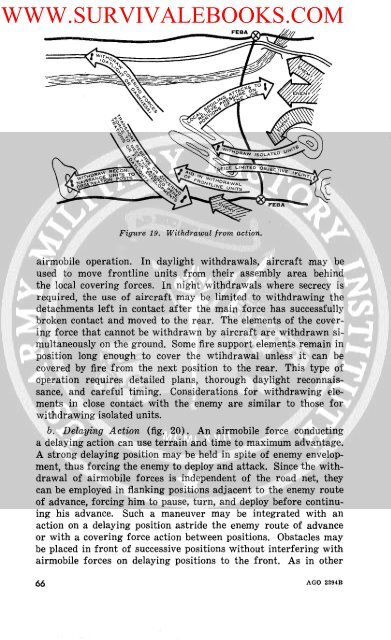FM 57-35 Airmobile Operations - Survival Books
FM 57-35 Airmobile Operations - Survival Books
FM 57-35 Airmobile Operations - Survival Books
- No tags were found...
You also want an ePaper? Increase the reach of your titles
YUMPU automatically turns print PDFs into web optimized ePapers that Google loves.
WWW.SURVIVALEBOOKS.COMFigure 19. Withdrawal from action.airmobile operation. In daylight withdrawals, aircraft may beused to move frontline units from their assembly area behindthe local covering forces. In night withdrawals where secrecy isrequired, the use of aircraft may be limited to withdrawing thedetachments left in contact after the main force has successfullybroken contact and moved to the rear. The elements of the covering force that cannot be withdrawn by aircraft are withdrawn simultaneously on the ground. Some fire support elements remain inposition long enough to cover the wtihdrawal unless it can becovered by fire from the next position to the rear. This type ofoperation requires detailed plans, thorough daylight reconnaissance, and careful timing. Considerations for withdrawing elements in close contact with the enemy are similar to those forwithdrawing isolated units.b. Delaying Action (fig. 20). An airmobile force conductinga delaying action can use terrain and time to maximum advantage.A strong delaying position may be held in spite of enemy envelopment, thus forcing the enemy to deploy and attack. Since the withdrawal of airmobile forces is independent of the road net, theycan be employed in flanking positions adjacent to the enemy routeof advance, forcing him to pause, turn, and deploy before continuing his advance. Such a maneuver may be integrated with anaction on a delaying position astride the enemy route of advanceor with a covering force action between positions. Obstacles maybe placed in front of successive positions without interfering withairmobile forces on delaying positions to the front. As in other66 AGO 2294B
















